
The Nitro group in organic sysnthesis - Feuer
.pdf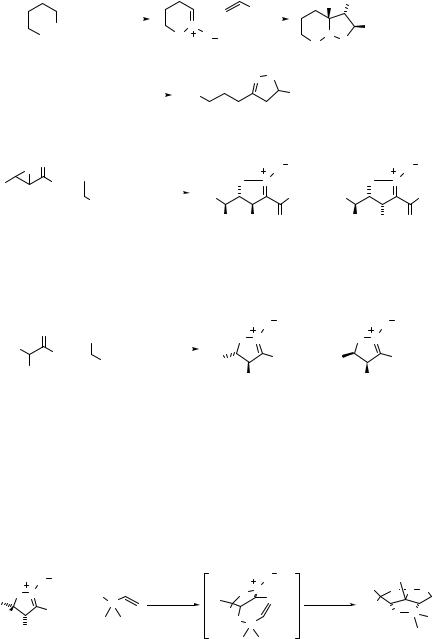
|
|
|
|
|
|
|
|
|
|
8.2 |
1,3-DIPOLAR CYCLOADDITION |
269 |
|||||||||||
|
|
|
|
|
|
|
|
|
|
|
|
|
CO2Me |
H |
H |
|
|
||||||
|
|
|
DBU |
|
|
|
|
|
|
|
|
|
|
|
|
||||||||
|
|
|
|
|
|
|
|
|
|
|
|
|
|
|
|
|
|||||||
|
|
|
|
|
|
|
|
|
|
|
|
|
|
|
|
|
|
|
|
|
|
|
|
|
NO2 |
|
CH2Cl2 |
|
|
|
O |
N |
|
|
|
|
|
|
|
|
CO2Me |
|
|||||
|
|
|
|
|
|
|
|
|
|
|
|
|
|
||||||||||
|
|
|
|
|
O |
|
|
|
|
|
|
|
|
|
|||||||||
|
I |
|
RT, 10 min |
|
|
|
|
|
|
|
O N O |
|
|
||||||||||
|
|
|
|
|
|
|
|
|
|
|
|
|
|
|
|
|
75% |
|
|
|
|
||
|
|
|
|
CF3CO2H |
|
|
|
|
N O |
|
|
|
|
|
|
|
|||||||
|
|
|
|
|
HO |
|
|
|
CO2Me |
|
|
|
|
(8.79) |
|||||||||
|
|
|
|
|
|
|
|
|
|
|
|
|
|
|
|
|
|||||||
|
|
|
|
|
|
|
|
|
|
(100%) |
|
|
|
|
|
|
|
|
|||||
|
O |
|
|
|
|
|
|
|
|
|
|
|
|
|
O |
|
|
|
|
|
|
O |
|
|
O |
CO2Et |
|
|
|
|
|
|
|
|
|
|
|
|
|
|
|
||||||
Me |
H |
Al2O3 |
|
|
|
O |
|
N |
|
|
|
|
O |
N |
|
||||||||
|
|
|
|
|
|
|
|
|
|
|
|
|
|||||||||||
|
|
|
|
|
|
|
|
|
|
Me |
|
|
|
OEt + |
|
Me |
|
|
|
|
OEt |
||
|
|
|
NO2 |
|
26 h |
|
|
|
|
|
|
|
|||||||||||
|
|
|
|
|
|
|
|
|
|
|
|
|
|
|
|
|
|
|
|||||
|
|
|
|
|
|
|
|
|
|
OH |
OH |
O |
|
|
OH |
OH |
O |
||||||
|
|
|
|
|
|
|
|
|
|
|
|
|
|
|
|
99% (ds = 1.5) |
|
(8.80) |
|||||
|
|
|
|
|
|
|
|
|
|
|
|
|
|
|
|
|
|
|
|
|
|
|
|
Treatment of 2-bromo aldehydes and ethyl nitroacetate with alumina gives 4-hydroxy-2- isoxazoline-2-oxides with high stereoselectivity (Eq. 8.81).131
|
O |
|
|
|
|
O |
|
|
|
O |
|
CO2Et |
Al2O3 |
O N |
O N |
|
|||||
Ph |
|
|
||||||||
H |
+ |
|
|
|
|
+ |
|
|
|
|
|
|
|
|
|
||||||
|
NO2 |
24 h |
Ph |
|
|
CO2Et Ph |
|
|
CO2Et |
|
|
Br |
|
|
|
|
|||||
|
|
|
||||||||
|
|
|
OH |
OH |
|
|||||
|
|
|
|
|
||||||
|
|
|
|
|
|
|
62% (trans/cis = 9/1) |
(8.81) |
||
The products shown in Eqs. 8.80 and 8.81 are good precursors for biologically important compounds such as polyhydroxylated amino acids, aminopolyols, and amino sugars. Furthermore, 4-hydroxy-2-isoxazoline 2-oxides can be converted into tricyclic compounds via silicontethered 1,3-dipolar cycloaddition reactions, as shown in Eq. 8.82.132 The temporary silicon connection methodology gives rise to the regioand stereoselective formation of new bonds by temporarily linking together the two reactants by means of an eventually removable silicon atom.133 This strategy is very useful for the control of stereochemistry in cycloaddition reactions (also see Section 8.3).
|
O N O |
|
|
|
|
O |
|
CO2Et |
|
2 |
|
ImH |
R1 |
O |
N |
R11 O N O |
|||
Cl |
Si |
|
CO2Et |
|
|
6 |
|||
R |
CO Et + |
MeCN |
|
2 |
|
R2 |
O |
Si 7 |
|
R1 |
2 |
|
|
R |
O Si |
|
|
||
|
OH |
|
|
|
|
|
|
80–99% |
|
|
|
|
|
|
|
|
|
||
(8.82)
One-pot multi-bond-forming reactions are one of the ways to address the ever growing demand for efficiency in organic synthesis. Rosini and coworkers have developed (tandem) processes for the synthesis of a highly functionalized tricyclic system. The reaction is simply performed by bringing together, at room temperature, α-bromo aldehydes, ethyl
nitroacetate, and chlorodimethylvinylsilane in the presence of imidazole as the base (Eq. 8.83).134

270 CYCLOADDITION CHEMISTRY OF NITRO COMPOUNDS |
|
|||||||
|
O |
|
CO2Et |
Cl |
|
|
n-C12H25 O |
N O |
n-C12H25 |
|
|
Si |
ImH |
|
|||
|
|
|
|
|||||
H |
+ |
NO |
+ |
|
O |
Si Me |
||
|
||||||||
|
|
|
|
|
||||
|
Br |
|
2 |
|
|
|
|
Me |
|
|
|
|
|
|
|
||
61% (cis/trans = 1/1) (8.83)
The cleavage of the tricyclic structure such as the product presented in Eq. 8.83 leads to a linear aminopolyhydroxylated structure (Scheme 8.25).135 Two-step unfolding (silyl ether hydroxydesilylation/nitroso acetal hydrogenolysis) can be useful in the preparation of hydroxylated amino acids (Eq. 8.84).
1 |
CO2Et |
i) KF, MCPBA, KHCO3, |
|
|
CO2Et |
|
|
||||
R |
O N O |
|
DMF, –15 ºC |
|
|
R1 |
O N O |
O |
O |
||
R2 |
O |
Si |
ii) Ac2O, Et3N |
|
|
2 |
|
|
NH2 |
||
|
|
|
|
|
R |
OAc |
OAc |
|
|
||
|
|
|
|
|
|
O |
|
|
|
||
|
|
|
|
|
|
|
|
5 |
6 |
OH |
|
|
|
H2 (1 atm) |
|
O |
NH2 |
|
O |
OH |
|||
|
|
|
|
|
|||||||
|
|
R2 |
|
|
(11) |
Anhydromyriocin |
|
||||
|
|
Raney-Ni |
R1 |
|
|
OH |
|
||||
|
|
MeOH |
|
|
|
OAc |
|
|
|
||
|
|
|
|
|
OAc |
|
|
|
(8.84) |
||
|
|
|
|
|
|
|
|
|
|
|
|
The present tandem nitro aldol-cyclization process is used for the preparation of the enantiomerically pure 4-hydroxy-2-isoxazoline-2-ones. They are prepared starting from chiral α-mesyloxy aldehydes and ethyl nitroacetate under mild reaction conditions (Eq. 8.85).136
|
OMs |
CO2Et |
|
Imidazole |
|
|
||
n-Pr |
|
O |
|
|
|
|||
|
+ |
|
|
|
|
|
||
|
|
H |
NO2 |
|
|
|
|
|
|
|
|
|
|
|
|
|
|
|
|
|
|
|
+ O– |
|
|
+ O– |
|
|
|
|
|
O N |
|
|
O N |
|
|
|
n-Pr |
|
CO2Et |
+ |
n-Pr |
|
|
|
|
|
|
|
CO2Et |
||
|
|
|
|
|
OH |
|
|
OH |
|
|
|
|
trans |
|
|
cis |
|
93% (trans/cis = 43/57)
(8.85)
Hassner and coworkers have developed a one-pot tandem consecutive 1,4-addition intramolecular cycloaddition strategy for the construction of fiveand six-membered heterocycles and carbocycles. Because nitroalkenes are good Michael acceptors for carbon, sulfur, oxygen, and nitrogen nucleophiles (see Section 4.1 on the Michael reaction), subsequent intramolecular silyl nitronate cycloaddition (ISOC) or intramolecular nitrile oxide cycloaddition (INOC) provides one-pot synthesis of fused isoxazolines (Scheme 8.26). The ISOC route is generally better than INOC route regarding stereoselectivity and generality.
Michael additions of secondary allylamines to nitroalkenes followed by treatment with Me3SiCl and Et3N afford highly functionalized pyrrolidines via the stereoselective ISOC reaction (Eq. 8.86).137
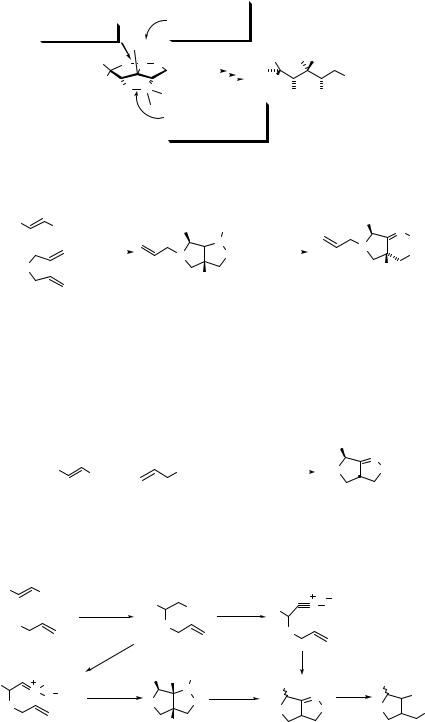
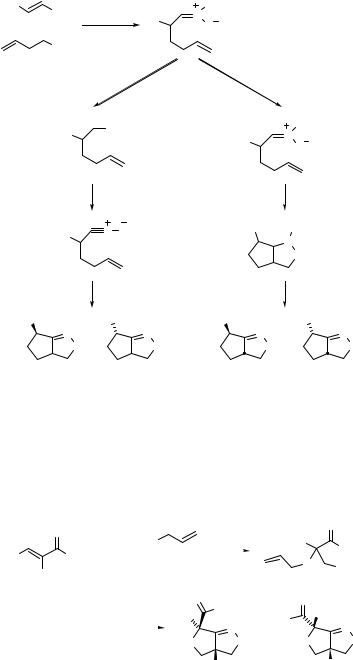
272 CYCLOADDITION CHEMISTRY OF NITRO COMPOUNDS
Ph |
NO2 |
|
OMgBr |
|
|
Ph |
N |
|
|
+ |
|
O |
|
|
|
–90 ºC |
|
||
|
|
|
|
|
|
MgBr |
|
|
|
|
|
|
Me3SiCl |
|
|
Ph |
NO2 |
|
OSiMe3 |
|
Ph |
N |
||
|
|
|||
|
|
78% |
O |
|
|
|
|
||
|
|
(t BOC)2O |
|
|
|
Ph |
N O |
Ph |
OSiMe3 |
|
|
|
N |
|
|
|
|
|
|
|
|
|
|
O |
Ph |
|
Ph |
Ph |
Ph |
N |
+ |
N |
N + |
N |
|
O |
O |
O |
O |
3.5 |
: |
1 |
trans |
cis |
80% (from nitro compound) |
66% (one pot; trans/cis = 99/1) |
|||
Scheme 8.27.
β-Nitrosulfides, formed by Michael addition of allyl mercaptan to β-nitroenones, undergo either INOC or ISOC to give tetrahydrothiopheno[3,4-c] isoxazolines. In this case, stereoselectivity of ISOC is also better than that of INOC (Eq. 8.88).140
|
|
O |
|
|
|
|
|
|
O |
|
|
||
|
|
HS |
|
|
|
Me |
|
|
|
|
|||
|
|
|
|
|
|
|
|
|
Me |
|
|||
|
|
|
|
|
|
|
|
|
|
|
|
|
|
O2N |
Me |
|
Et3N |
|
|
S |
|
||||||
|
|
|
NO2 |
|
|||||||||
|
|
Me |
|
|
|
|
|
99% |
|
|
|||
|
|
|
|
|
|
|
|
|
|
|
|
||
|
|
|
|
|
|
O |
|
|
O |
|
|
|
|
|
|
|
|
|
|
Me |
|
|
|
Me |
|
|
|
|
|
PhNCO, Et3N (INOC) |
|
|
Me |
|
|
Me |
|
|
|||
|
|
|
|
|
|
|
|
N |
|
||||
|
|
|
|
|
|
N |
+ |
|
|
|
(8.88) |
||
|
or 1) Me3SiCl, Et3N (ISOC) |
|
|
|
|||||||||
|
S |
O |
S |
|
|
O |
|
||||||
|
|
2) HCl |
|
|
|
|
|
|
|
|
|
|
|
|
|
|
|
|
|
|
|
|
|
|
|
||
|
|
|
|
|
|
H |
|
|
|
H |
|
|
|
|
|
INOC |
89% |
71 |
|
|
: |
29 |
|
|
|
||
|
|
ISOC |
82% |
4 |
|
|
: |
96 |
|
|
|
||
Asymmetric 1,3-dipolar cycloaddition of nitronates using chiral alkenes has been reported, as shown in Eq. 8.89141,142 and Eq. 8.90.143
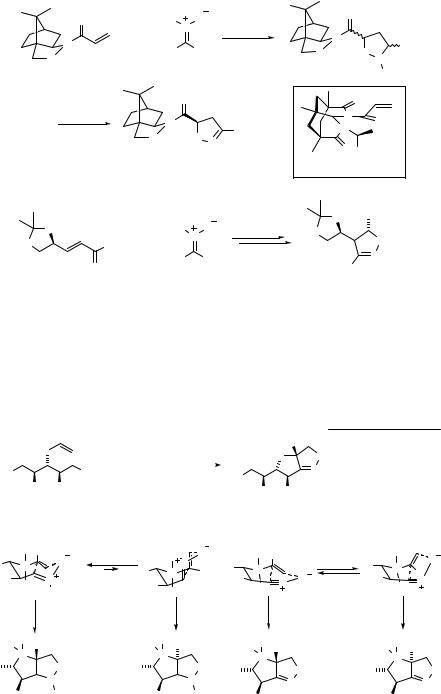
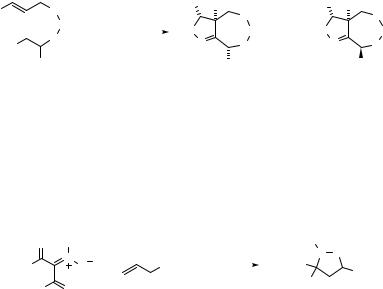
274 CYCLOADDITION CHEMISTRY OF NITRO COMPOUNDS
The use of silylketals derived from allylic alcohols and 1-substituted nitroethanols for the stereocontrolled synthesis of 3,4,5-trisubstituted 2-isoxazolines via intramolecular 1,3-dipolar cycloaddition has been demonstrated. Here again, the use of silyl nitronates (ISOC) increases the level of selectivity compared to INOC (Eq. 8.92).145
Ph |
O |
|
|
Ph |
|
H |
|
Ph |
H |
|
|
|
|
|
|
O |
|
|
|
|
O |
||
|
SiPh2 |
|
|
|
|
|
|
|
|
||
|
|
|
O |
|
SiPh2 |
+ |
O |
|
|
SiPh2 |
|
|
O |
|
|
|
|
|
|||||
O2N |
|
|
|
N |
O |
|
N |
|
|
O |
|
Me |
|
|
|
|
|
|
|||||
|
|
|
|
|
|
||||||
|
|
|
|
|
Me |
|
|
Me |
|
||
|
|
PhNCO, Et3N |
|
40 |
: |
|
60 |
(8.92) |
|||
|
|
Me3SiCl, Et3N |
|
70 |
: |
|
30 |
||||
|
|
|
|
|
|||||||
Nitronates show a similar reactivity to that of nitrones, and nitrones are one of 1,3-dipoles that have been successfully developed to catalyzed asymmetric versions, as discussed in the section on nitrones (Section 8.2.1). However, asymmetric nitronate cycloadditions catalyzed chiral metal catalysts have not been reported. Kanemasa and coworkers have demonstrated that nitronate cycloaddition is catalyzed by Lewis acids (Eq. 8.93).146 This may open a new way to asymmetric nitronate cycloaddition catalyzed by chiral catalysts.
O |
OMe |
|
|
MeO |
|
|
|
N |
|
RT |
N O |
|
|
|
OMgBr |
MeO2C |
|
|||
MeO |
O + |
|
CH2OH |
|||
1 h |
||||||
|
|
|
MeO2C |
|||
MeO |
O |
|
|
|
||
|
|
quant. |
(8.93) |
|||
|
|
|
|
1,3-Dipolar addition to nitroalkenes provides a useful strategy for synthesis of various heterocycles. The [3+2] reaction of azomethine ylides and alkenes is one of the most useful methods for the preparation of pyrolines. Stereocontrolled synthesis of highly substituted proline esters via [3+2] cycloaddition between N-methylated azomethine ylides and nitroalkenes has been reported.147 The stereochemistry of 1,3-dipolar cycloaddition of azomethine ylides derived from aromatic aldehydes and L-proline alkyl esters with various nitroalkenes has been reported. Cyclic and acyclic nitroalkenes add to the anti form of the ylide in a highly regioselective manner to give pyrrolizidine derivatives.148
8.3 NITROALKENES AS HETERODIENES IN TANDEM [4+2]/[3+2] CYCLOADDITION
Recently, Denmark and coworkers have developed a new strategy for the construction of complex molecules using tandem [4+2]/[3+2]cycloaddition of nitroalkenes.149 In the review by Denmark, the definition of tandem reaction is described; and tandem cascade cycloadditions, tandem consecutive cycloadditions, and tandem sequential cycloadditions are also defined. The use of nitroalkenes as heterodienes leads to the development of a general, high-yielding, and stereoselective method for the synthesis of cyclic nitronates (see Section 5.2). These dipoles undergo 1,3-dipolar cycloadditions. However, synthetic applications of this process are rare in contrast to the functionally equivalent cycloadditions of nitrile oxides. This is due to the lack of general methods for the preparation of nitronates and their instability. Thus, as illustrated in Scheme 8.29, the potential for a tandem process is formulated in the combination of [4+2] cycloaddition of a donor dienophile with [3+2]cycload-
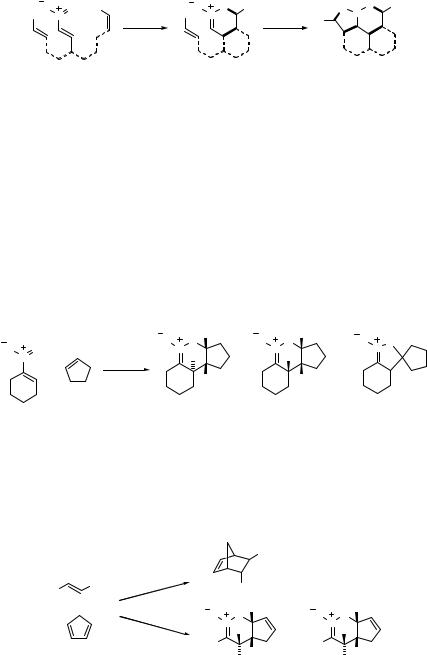
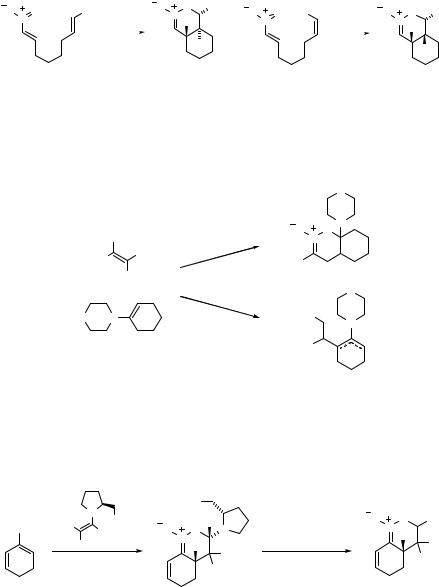
276 CYCLOADDITION CHEMISTRY OF NITRO COMPOUNDS |
|
|
|
|
|||||||
O O |
Me |
|
O |
O |
Me |
O O Me |
|
O O Me |
|||
|
|
N |
|
|
|||||||
N |
|
SnCl4 |
|
H |
|
N |
SnCl4 |
N |
|||
|
|
|
|
|
|
H |
|||||
|
|
|
|
|
|
||||||
|
|
–76 ºC |
|
|
H |
|
|
–76 ºC |
|
|
|
|
|
|
|
|
|
H |
|||||
|
|
|
|
|
|
|
|
|
|
||
91% |
(8.96) |
|
The powerful nucleophilicity of enamines allows the addition of nitroalkenes to take place without the presence of Lewis acids. The isolation of secondary products, which can be explained by an initial Michael addition, suggests the participation of zwitterionic intermediates in the mechanism of the reaction (Eq. 8.97).154
|
|
|
O |
|
|
|
|
N |
|
NO2 |
R1 = Me, R2 = H |
O O |
|
|
N |
|
|||
R1 |
H |
|
Me |
|
|
|
|
||
R2 |
|
|
80% |
(8.97) |
+ |
|
|
|
O |
|
|
|
|
|
O N |
1 |
2 |
O2N |
N |
|
R |
= H, R = Me |
|
|
Me
85%
An interesting Diels-Alder reaction using chiral enamines is reported by Backvall, in
which a cyclic nitronate is formed in good yield and excellent diastereoselectivity (Eq. 8.98).155
|
|
N |
MeO |
|
|
|
|
|
|
H |
|
O O OH |
|
|
Me |
OMe |
|
|
||
NO2 |
H |
O O |
N |
|
N |
|
|
|
|||||
|
|
Me |
N |
|
KOH |
H |
|
|
H |
Me |
Me |
||
|
|
|
|
MeOH/H2O |
Me |
|
|
|
|
|
Me |
||
|
|
|
|
|
|
(8.98)
72% (99% de) |
78% |
The use of oxygen-containing dienophiles such as enol ethers, silyl enol ethers, or ketene acetals has received considerable attention. Yoshikoshi and coworkers have developed the simple addition of silyl enol ethers to nitroalkenes. Many Lewis acids are effective in promoting the reaction, and the products are converted into 1,4-dicarbonyl compounds after hydrolysis of the adducts (see Section 4.1.3 Michael addition).156 The trimethylsilyl enol ether of cyclohexanone reacts with nitrostyrenes in the presence of titanium dichloride diisopropoxide [Ti(Oi-Pr)2Cl2], as shown in Eq. 8.99.157 Endo approach (with respect to the carbocyclic ring) is favored in the presence of Ti(Oi-Pr)2Cl2. Titanium tetrachloride affords the nitronates nonselectively.
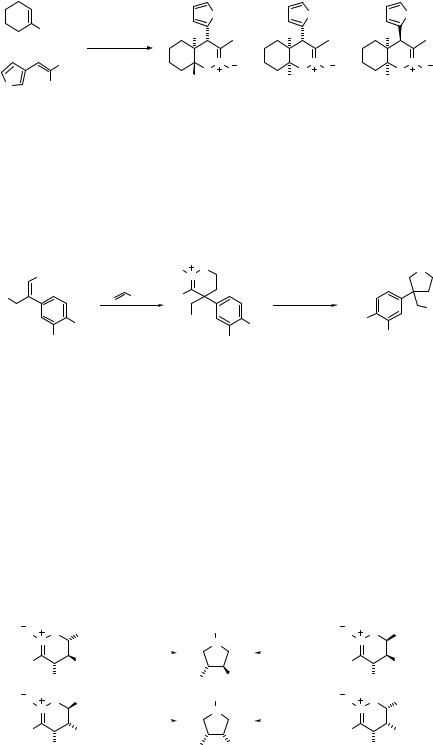
|
8.3 NITROALKENES AS HETERODIENES IN TANDEM [4+2]/[3+2] CYCLOADDITION |
277 |
||||||
|
|
|
O |
|
O |
|
|
O |
|
OSiMe3 |
(i-PrO)2TiCl2 |
H |
|
H |
|
H |
|
|
+ |
|
+ |
|
+ |
|
|
|
|
–90 ºC, 1.5 h |
|
|
|
|
|||
|
NO2 |
N |
|
N |
|
|
N |
|
|
|
|
|
O |
||||
|
|
|
O O |
|
O O |
|
O |
|
O |
Me |
|
Me3SiO |
|
Me3SiO |
|
Me3SiO |
|
|
1 |
: |
4 |
: |
1 |
(8.99) |
||
|
|
|
||||||
(total yield 96%)
Denmark and coworkers have found that methylaluminum bis (2,6-di-tert-butyl-4-methyl- phenoxide) (MAD) or methylaluminum bis(2,6-diphenylphenoxide) (MAPh) is effective as the Lewis acid promoter for cycloaddition of 2,2-disubstituted 1-nitroalkenes (Eq. 8.100).158 Other Lewis acids such as SnCl4, TiCl4, and TiCl2(Oi-Pr)2 fail to promote the cycloaddition of 2,2-disubstituted 1-nitroalkenes. The products are converted into 3,3-disubstituted pyrrolidines via hydrogenolysis.158 Reductive cleavage of N–O bonds produces oxime hemiacetals, which are further reduced to amido aldehydes and finally to pyrrolidines. This reaction provides a useful synthetic method for pyrrolidines, which is discussed later.
|
|
O O |
|
|
H |
NO2 |
|
|
|
N |
|
|
N |
|
|
|
|
Me |
OBu |
H |
|
H2, PtO2 |
|
|
MAD |
Me |
|
MeOH |
Me |
|
|
|
|||
OMe |
toluene, 0 ºC |
OMe |
MeO |
|
|
|
OMe |
(8.100 |
|||
OMe |
|
OMe |
|
||
|
|
|
|
||
|
|
80% |
|
98% |
|
The mode of cycloaddition of (E)- and (Z)-1-propenyl ether with (E)-nitrostyrene (exo versus endo) and attendant stereostructure of the final product is dependent on the configuration of the vinyl ether and the Lewis acids employed (Scheme 8.30). Reactions conducted with TiCl2(O-i-Pr)2 produce nitronates that are enriched in isomers derived from an endo (EtO) approach of the dienophiles. It is believed that the transition structure of the titanium-promoted nitroalkene [4+2] cycloaddition is highly polarized, placing a partially positive charge on the nitrogen atom of the alkene. Therefore, the participating vinyl ether assumes an endo orientation of the electron-rich alkoxy group due to stabilizing interactions. In contrast, reactions performed using MAPh produce nitronates that are enriched in isomers derived from an exo approach. A preference for the exo orientation of a vinyl alkoxy group in nitroalkene [4+2] cycloaddition promoted by MAPh is the general trend. It is believed that the bulk of the aluminum-based Lewis acid forces the alkoxy group to take up an exo orientation to minimize nonbonded interactions.
Hydrogenolysis of the individual nitronate diastereomers presented in Scheme 8.30 provides the corresponding transand cis-3,4-disubstituted pyrrolidines in good yields (Eq. 8.101).158
O |
O |
OEt |
|
Ts |
|
|
O |
O |
OEt |
|
N |
|
i) H2/PtO2 |
N |
|
i) H2/PtO2 |
|
N |
|
H |
|
Me ii) Et3N, TsCl |
|
|
ii) Et3N, TsCl H |
|
Me |
||
|
Ph |
|
78% |
Ph |
Me |
79% |
|
Ph |
(8.101) |
|
|
|
|
|
|||||
|
|
|
|
|
|
|
|
|
|
O |
O |
OEt |
|
Ts |
|
|
O |
O |
OEt |
|
|
|
|
||||||
|
N |
|
i) H2/PtO2 |
N |
|
i) H2/PtO2 |
|
N |
|
H |
|
Me |
ii) DBU, TsCl |
|
|
ii) DBU, TsCl |
H |
|
Me |
|
83% |
|
|
65% |
|
||||
|
Ph |
|
Ph |
Me |
|
Ph |
|
||
|
|
|
|
|
|
||||
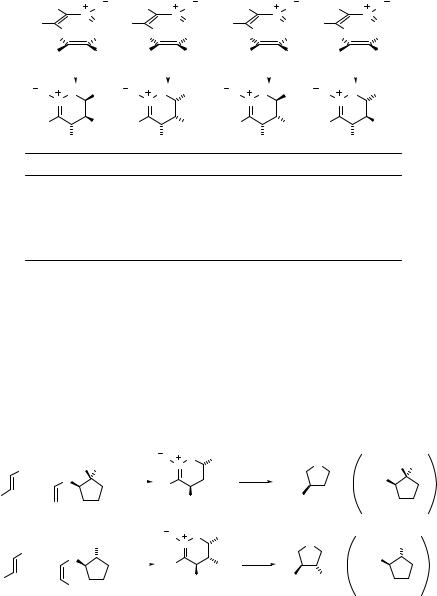
278 CYCLOADDITION CHEMISTRY OF NITRO COMPOUNDS
(Z)-1-propenyl ether |
|
|
(E)-1-propenyl ether |
|
|||||||||
exo |
|
endo |
|
|
exo |
|
|
endo |
|
||||
H |
O |
H |
O |
|
H |
O |
|
H |
O |
||||
Ph |
N |
|
N |
O |
Ph |
|
|
N |
Ph |
|
N |
O |
|
O |
Ph |
|
|
O |
|
|
|||||||
H H |
H |
Me H |
OEt |
Me H |
H |
|
H H |
OEt |
|||||
Me |
OEt |
H |
H |
|
H |
OEt |
Me |
H |
|||||
|
|
|
|
|
|
|
|
|
|
|
|
|
|
|
|
|
|
|
|
|
|
|
|
|
|
|
|
O O |
OEt |
O O |
OEt |
O |
O |
OEt |
O |
O |
OEt |
||||
N |
|
N |
|
|
N |
|
|
N |
|
||||
H |
Me |
H |
Me |
H |
|
|
Me |
H |
|
|
Me |
||
Ph |
|
Ph |
|
|
Ph |
|
|
Ph |
|
||||
Lewis acid (equiv) |
Enol ether |
Yield (%) |
Ratio exo/endo |
Ratio cis/trans |
|||||||||
MAPh (2.0) |
E |
88 |
|
58:42 |
|
58:42 |
|
||||||
MAPh (3.0) |
Z |
92 |
|
88:12 |
|
12:88 |
|
||||||
TiCl2(OPri)2 (3.0) |
E |
89 |
|
6:94 |
|
6:94 |
|
||||||
TiCl2(OPri)2 (3.0) |
Z |
84 |
|
10:90 |
|
90:10 |
|
||||||
Scheme 8.30.
2-Substituted 1-nitroalkenes undergo highly diastereoselective Lewis-acid-promoted [4+2] cycloadditions with chiral vinyl ethers derived from (R)-2,2-diphenylcyclopentanol and (1R, 2S)-2-phenylcyclohexanol to afford cyclic nitronates in high yields. The resulting nitroates are reduced with hydrogen at 160 psi in the presence of platinum oxide to afford enantiomerically enriched pyrrolidines in good yields, as shown in Eqs. 8.102 and 8.103.159 The chiral auxiliaries are recovered in nearly quantitative yields after hydrogenation.
|
|
|
O |
O |
OG* |
|
|
H |
|
|
|
Ph Ph |
|
|
N |
Ph Ph |
|||
NO2 |
|
N |
|
H2 |
|
||||
+ O |
MAPh |
|
|
|
|
HO |
|||
|
|
|
|
+ |
|||||
|
H |
|
|
PtO2 |
|
||||
Ph |
|
|
|
|
Ph |
|
|
||
|
|
|
Ph |
|
|
|
|||
|
|
|
|
|
|
|
|||
|
|
|
|
|
|
|
|
100% |
|
|
|
|
95% (90% de) |
|
74% (88% ee) |
||||
|
|
|
|
(8.102) |
|||||
|
|
|
|
|
|
|
|
|
|
|
|
Ph |
O |
O |
OG* |
|
|
H |
Ph |
NO2 |
|
|
N |
|
|
|
N |
||
|
O |
MAPh |
|
|
H2 |
|
+ |
HO |
|
|
+ |
|
Ph |
|
|||||
|
|
H |
|
PtO2 |
|
|
|||
Ph |
|
|
|
Ph |
|
Ph |
Ph |
|
|
|
Ph |
|
|
|
100% |
||||
|
|
96% (87% de) |
|
85% (99% ee) |
|||||
|
|
|
|
|
|||||
(separation) |
(8.103) |
|
2-(Acyloxy)vinyl ethers undergo regioselective [4+2] cycloadditions with nitroalkenes to produce substituted 5-acetoxy nitronates in good yields. The resulting nitronates can be converted into 3-hydroxy-4-substituted-pyrrolidines by hydrogenolysis. A chiral 2-acetoxy- vinyl ether derived from (R)-2,2-diphenylcyclopentanol is employed in the cycloaddition-hy-
drogenation sequence to prepare optical active N-tosyl-3-hydroxypyrrolidines in 96% ee (Eq. 8.104).160
